Lecture
Practically everyone perfectly understands the language of the movement of politicians, because we know that politicians constantly pretend that they believe in something they absolutely do not believe in, and they pretend that they are not at all what they really are. They spend most of their time pretending, dodging, dodging, deceiving, hiding emotions and feelings, hiding behind smoke screens and mirrors, welcoming imaginary friends in the crowd. But we instinctively feel that their bodies are sending us contradictory signals. Therefore, we prefer to see politicians at close range in order to bring them to the clear water.
What signal tells us that the politician is lying?
His lips move.
For one television program, we conducted an experiment. This time we used the local tourist office. Tourists entered the office to get information about the sights and places of interest in the city. They were sent to the counter, where they talked with a bureau employee - a young man with blond hair and a mustache, in a white shirt and tie. After a few minutes of conversation, the young man leaned under the counter to get the booklets. And then from there came a completely different man - shaved, with dark hair, in a blue shirt and without a tie. He continued to talk with a tourist from the same place where the first employee interrupted. Surprisingly, almost half of the tourists did not notice that she was talking to another person. Neither men nor women paid attention either to the change in the character of the body language or to the completely different appearance of the interlocutor. If you do not have the innate ability to read body language signals, you are likely to miss important information. In this book, we will tell you about what you do not notice.
Kinesika (other Greek: κίνησις - movement) -
KINESICA (DR. GREEK. ΚΊΝΗΣΙΣ - MOVEMENT) —– a set of body movements (gestures, facial expressions) used in the process
human interaction (with the exception of the movements of the speech apparatus). Kinesika studies the reflection of human behavior in its non-verbal manifestations, which include facial expressions, pantomime, “vocal facial expressions” (intonation, timbre), spatial pattern (zone, territory), expression, which can be decisive in the interpretation of pronounced statements.
Kinesics
KINESIC MEANS Kinetic agents are visually perceived movements of another person that perform an expressively regulatory function in communication. Kinesics include expressive movements manifested in facial expressions, poses, gestures and looks.
1. Facial expressions. A special role in transmitting information is given to facial expressions - facial muscle movements
MIMIKA: A SPECIAL ROLE IN THE TRANSMISSION OF INFORMATION IS GIVEN TO MIMIKA - THE MOVEMENT OF THE FACE MUSCLES
Facial expressions are expressive changes in the face. It reflects the mental state of a person, attitude to the environment, the speaker’s own statements and actions. In the eyes and in the whole appearance of the speaker there is as much eloquence as in his words.
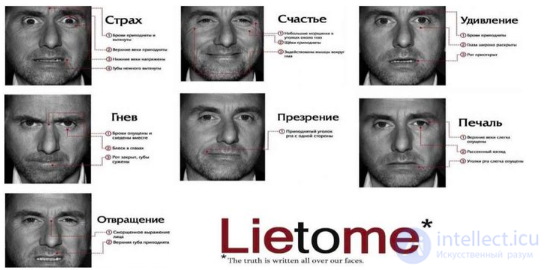
2. A look. A look, or visual contact, which is a very important part of communication, is very closely related to facial expressions.
SIGHT. VISUAL VISIT OR VISUAL CONTACT IS VERY CLOSELY CONNECTED WITH MIMIC
IMPORTANT PART OF COMMUNICATION Using the eyes, the most accurate signals about the state of a person are transmitted, since the expansion and contraction of the pupils are not subject to conscious control. Thus, not only facial expression carries information about a person, but also his gaze.
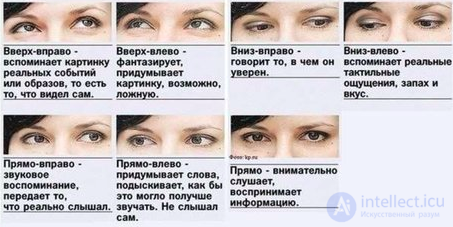
3. Pose - this is the position of the human body, typical for a given culture, an elementary unit of spatial behavior
POSE IS THE POSITION OF THE HUMAN BODY, TYPICAL FOR THIS CULTURE, ELEMENTARY
UNIT OF SPATIAL HUMAN BEHAVIOR. The main semantic content of the pose consists in the individual placing his body in relation to the interlocutor.


4. Gestures. As easily as a pose, the meaning of gestures can be understood - various movements of the arms and head, the meaning of which
GESTURES. SO EASY, AS THE POSITION MAY BE UNDERSTANDED AND THE SIGNIFICANCE OF GESTURES - VARIETY OF MOVEMENTS BY HANDS AND
HEAD, THE MEANING OF WHICH IS UNDERSTANDING FOR COMMON PARTIES. In the process of communication do not forget about congruency,
i.e., about the coincidence of gestures and speech utterances. Speech utterances and the accompanying gestures must match. The contradiction between gestures and the meaning of statements is a signal of lies.
Below are hand gestures and their meaning. Gestures and postures characteristic of a person with non-verbal communication are accompanied by pictures.
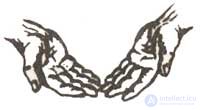 |
Open palms A gesture of openness and truthfulness, recognition of the authority of the interlocutor, trust in him. Best hand gesture.
|
 |
Palms turned to themselves A cordial invitation to mutual understanding and closer contact. Words coming from the heart |
 |
Sharply turning hands The interlocutor tries to be correctly understood, actively gestures, is quite frank in his statements. |
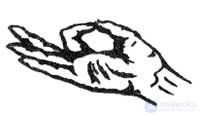 |
Thumb and forefinger touch |
 |
Palms up, fingers half bent Attracting leadership, power. The desire to dominate and manage the situation. |
 |
Clasped hands gesture Hands are twisted in the face, they signal in unjustified expectations and in an attempt to hide their negative attitude. |
 |
Gesture of hands clasped lying on a table or on knees, if a person is sitting |
 |
Gesture "Pyramid" It testifies to self-confidence, as if replacing the words "I know all this." Characteristic for leaders in a conversation with subordinates, for people giving instructions to others. |
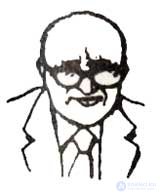 |
Aggression |
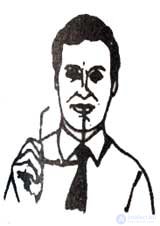 |
Nibbling glasses
|
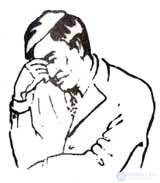 |
Thinker |
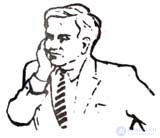 |
Boredom Actual interest is shown when the hand is also slightly leaned against the cheek, but does not support the head. The fingers are bent.
|
 |
Critical Assessment When the index finger points vertically up the cheek and the thumb supports the chin, this indicates that the listener negatively or critically evaluates the speaker or the situation as a whole. Not to be confused with a gesture of interest |
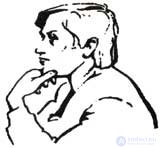 |
Chin stroking
|
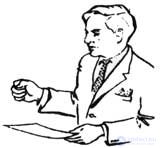 |
Authoritarianism, aggressiveness The desire to command, to impose their own rules of conduct. The right hand is clenched. I am fist and raised, as for a blow. Often accompanied by threats and increased voice. |
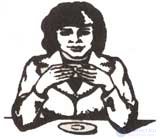 |
Readiness for contact Loose posture, head straight, calm facial expression, slight smile. A manifestation of openness and sincerity. |
 |
I listen and obey
|
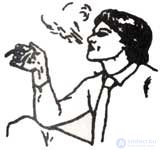 |
Smoke up If a person blows smoke, then he experiences positive feelings: self-confidence, superiority over someone, a positive assessment of the situation. |
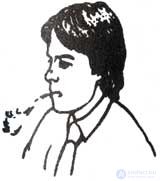 |
Smoke down If the smoke goes down, then the person experiences negative emotions, negatively assesses the situation, suspects you of something bad, or tries to hide some thoughts himself. If a person releases smoke down and through the corner of his mouth, this indicates his strong negative attitude towards the situation and his secretive nature. |
8. Congruence
CONGRUENCE
- a condition in which a person’s words correspond to his actions. His non-verbal signals and verbal statements correspond to each other. The state of integrity, adequacy, inner harmony, lack of conflict. Congruent person - this is the first
it’s the one who never lies and never lies to others. Such a person is attractive and inspires confidence. Such people want to open up,
because you too get involved in his sincere and open communication without falsehood. Such a person can easily find a common language with other people.
Pictures on request Congruence

9. Kinesic knowledge is necessary for everyone to better navigate in various communication situations, consciously giving the necessary signals
at a non-verbal level, purposefully influencing the interlocutor, disposing him to himself. Mastering inesic knowledge and skills, you can
keep yourself in the right state of health, attitude, acting on your psyche through your own posture, movement, gesture.
Comments
To leave a comment
Body language
Terms: Body language